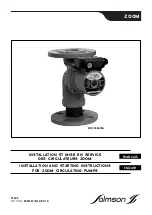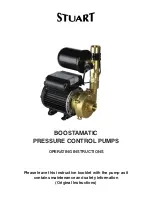
22
C-3.2) Insulation Test:
Before the pump is put into service, an insulation (megger)
test should be performed on the motor. The resistance
values (ohms) as well as the voltage (volts) and current
(amps) should be recorded on the start-up report. Pumps/
systems with an insulation value of less than 5 M-Ohms
should be investigated for moisture or damaged cables
before proceeding.
C-3.3) Pump-Down Test:
After the pump has been properly wired and lowered into
the basin, sump or lift station, it is advisable to check
the system by filling with liquid and allowing the pump
to operate through it’s pumping cycle. The time needed
to empty the system, or pump-down time along with the
volume of water, should be recorded on the start-up report.
IMPORTANT! THE MAXIMUM ALLOWABLE STARTS
PER HOUR IS 15, EVENLY SPACED.
SECTION D: PREVENTATIVE MAINTENANCE
As the motor and seal chamber are oil-filled, no lubrication
or other maintenance is required, and generally Barnes
Pumps will give very reliable service and can be expected
to operate for years of normal sewage pumping without
failing. However, as with any mechanical piece of equipment
a preventive maintenance program is recommended and
suggested to include the following checks:
1) Test moisture detector control “Test Switch” for
continuity of circuit. Water in the seal chamber will
energize a seal leak warning light at the control
panel. This is a warning light only and does not
stop the motor. It indicates the seal has leaked
and must be repaired. This should be done within 2
or 3 weeks to prevent further damage. See section
C-2.2.
2) Inspect impeller and body for excessive build-up or
clogging and repair as required per section E-2.
3) Inspect outer shaft seal and replace as required
per section E-3.
4) Check motor for ground leakage and proper amp
draw.
SECTION E: SERVICE AND REPAIR
NOTE: All item numbers in ( ) refer to Figures 10, 11 & 12.
WARNING ! - Electrical power to the
pump motors must be disconnected and
locked out to prevent any dangerous
electrical hazards or personnel danger
before any service work is done to the
pump.
CAUTION ! - Operating pump
builds up heat and pressure;
allow time for pump to cool
to room temperature before
handling or servicing.
E-1) Lubrication
E-1.1) Checking Oil
1. Place pump on it’s side, and drain oil into a clean, dry
container.
2. Check oil for contamination using an oil tester with a
range to 30 Kilovolts breakdown.
3. If oil is found to be clean and uncontaminated (measure
above 15 KV. breakdown), refill the seal chamber as per
section E-1.2.
4. If oil is found to be dirty or contaminated (or measures
below 15 KV. breakdown), the pump must be carefully
inspected for leaks at the shaft seal (4), before refilling
with oil. To locate the leak, perform a pressure test as per
section E-1.3. After leak is repaired, refill with new oil as
per section E-1.2.
E-1.2) Replacing Oil:
Seal Chamber - Drain all oil from seal chamber and dispose
of properly. Refill with (see parts list for amount) new cooling
oil as per Table 2. An air space must remain to compensate
for oil expansion (See Fig. 9 and 12). Set unit on side and
fill.
IMPORTANT! - Do not overfill oil.
Overfilling of seal chamber with oil
can create excessive and dangerous
hydraulic pressure which can destroy the
pump and create a hazard. Overfilling oil
voids warranty.
E-1.3) Pressure Test:
Seal Chamber - Before checking the pump for leaks around
the shaft seal, the oil level should be full. Remove pipe plug.
Apply pipe sealant to pressure gauge assembly and tighten
into pipe plug hole. Pressurize motor housing to 10 P.S.I.
Use a soap solution around the sealed area and inspect
joints for “air bubbles”. If, after five minutes, the pressure
is still holding constant, and no “bubbles” are observed,
slowly bleed the pressure and remove the gauge assembly.
Replace the pipe plug using a sealant. If the pressure does
not hold, then the leak must be located.
CAUTION! - Pressure builds up
extremely fast, increase pressure by
“tapping” air nozzle. Too much pressure
will damage seal. Do Not exceed 10 P.S.I.
in seal chamber.
TABLE 2 - COOLING OIL - Dielectric
SUPPLIER
GRADE
BP
Enerpar SE100
Conoco
Pale Paraffin 22
Mobil
D.T.E. Oil Light
G & G Oil
Circulating 22
Imperial Oil
Voltesso-35
Shell Canada
Transformer-10
Texaco
Diala-Oil-AX
Woco
Premium 100
E-2) Impeller and Volute Service:
E-2.1) Disassembly and Inspection:
To clean out the volute (10), or clean out or replace impeller
(6), disconnect power, remove cap screws (2) then vertically
lift motor assembly from the pump body (10). Clean out
the volute, if necessary, clean and examine impeller (6)
for pitting or wear, replace if required. To remove Impeller
(6), remove cap screw (8) and washer (8A). The impeller is
keyed onto the shaft with a square key (7) and to remove,
pull impeller straight off the shaft using a wheel puller if
required. Inspect o-ring (9) and replace if cut or damaged.
Before reinstallation, check the motor shaft and impeller
bore for damage.
Summary of Contents for BARNES 10SHD Series
Page 27: ...27 FIGURE 10 SH Pump Series Cross Sections Before March 2016 FIGURE 11 SH Vortex SH Enclosed ...
Page 28: ...28 FIGURE 12 SH Enclosed Pump Series Exploded Views Before March 2016 ...
Page 31: ...31 FIGURE 13 SH Pump Series Cross Sections After March 2016 FIGURE 14 SH Vortex SH Enclosed ...
Page 32: ...32 FIGURE 15 SH Enclosed Pump Series Exploded Views After March 2016 ...
Page 55: ...Notes ...
Page 56: ...Notes ...
















































